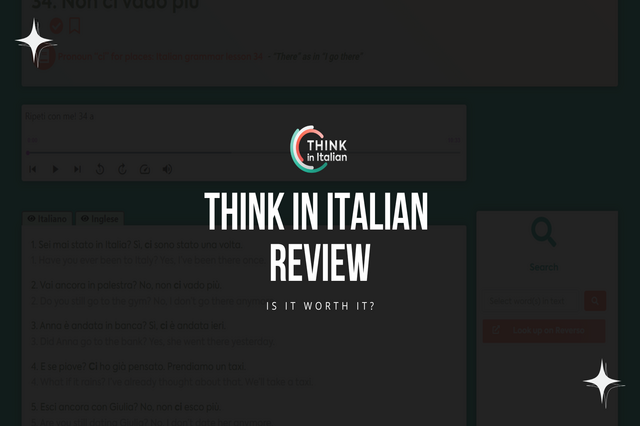
In 2018 someone introduced me to an Italian language course asking me to review it which I already did. Fast forward to 2022, I decided to update it since a lot has changed.
Before I begin, I wanted to let you know I had completely forgotten what I had learned before so I started with a clean slate. Please note that I’ll be focusing on the online version only. Toward the end, you’ll find out whether Think In Italian is worth it.
Think In Italian (TII) is an audio-based Italian course focused on speaking, listening, and reading, designed around spaced repetition.
Key parts: Ripeti Con Me (repeat-after-me) has 3-part lessons, and Leggi Con Me (read-after-me) offers short readings.
Offers grammar notes, a searchable transcript, a community comment section, monthly live streams, and live-tutor options.
Pricing: Monthly (US$39.80), yearly (US$357), or lifetime (US$980), plus a 7-day trial.
My experience (after 2+ months):
Pros: Minimal design, natural sentence patterns, effective spaced-repetition, active community, hands-on support, builds “thinking in Italian.”
Cons: Weak on writing practice, site UX issues, some audio/ timing bugs, no visuals or exercises beyond listening.
Conclusion: Solid course for listening and speaking, recommended as a core or supplementary tool, but not enough alone for full language mastery.
Formerly known as Impara con Me/ Ripeti Con Me/ Fluent Simple it’s a valuable resource for Italian learners.
Packed inside among many others are two audio-based courses (Ripeti Con Me and Leggi Con Me) that focus solely on the speaking, listening, and reading aspects and are crafted with the principle of spaced repetition in mind.
The first 15 lessons of RCM were launched in early 2018 by Stefano Lodola, a teacher who speaks 12 languages (at various levels). In 2019, Leggi Con Me was created as free content but is now included in the membership.
According to him, he created Ripeti Con Me because he was ‘tired of recommending a second-best solution’ when his students asked for the best Italian course.
“My course is an improved version of what used to be an audio course, now turned into an app, called Glossika” – Stefano Lodola
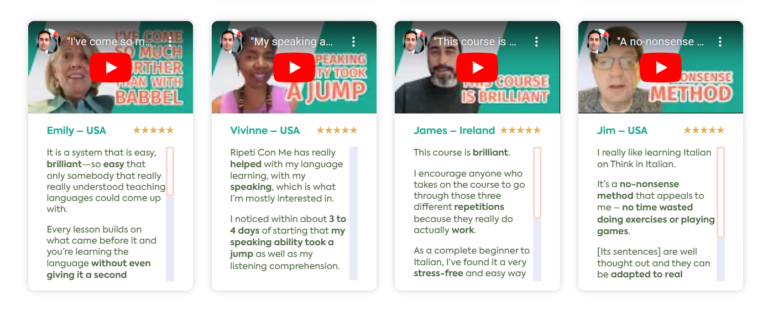
As of writing, there are 249 RCM lessons and 700+ LCM readings available. More will be added in the future. It has a 5-star rating on Trustpilot and Trustindex from users. I’ll give my rating at the end of this post.
The target audience is total beginners (A0) up to advanced (C1) learners. This is perfect if you’re on any of those levels and just want to learn straight away without any distractions. Each feature has its own benefit.
You’ll find out what they are below.
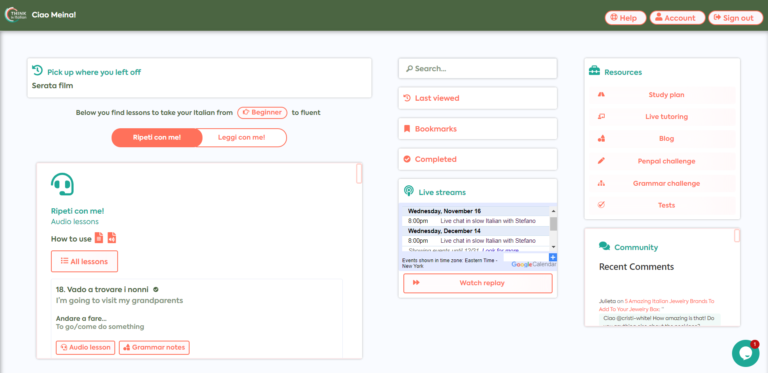
This is where you can access everything you need. When you first log in, you’ll be given a quick tutorial on what these are.
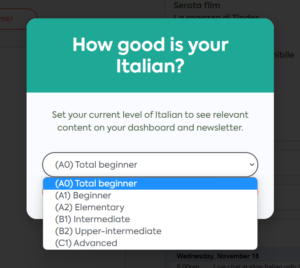
This is the very first thing you need to do. The content on the dashboard will change once you set your level. You’ll also receive newsletters in your email based on that. The level ends with C1 instead of C2. Why? Here’s his reply
C2 is a unicorn. And if they're really at that level, they'd look for native materials like novels or news, not language courses.
Ripeti Con Me (RCM) means repeat after me. Leggi Con Me means read after me. Click on the document or audio icons to find out how to use them correctly.
More on this on ‘how does it work’ below. Let’s check the stats:
Total Beginner (A0)
Ripeti Con Me - 17 Lesson
Leggi Con Me - 72 stories
Beginner (A1)
Ripeti Con Me - 43 Lessons
Leggi Con Me - 165 stories
Elementary (A2)
Ripeti Con Me - 60 Lessons
Leggi Con Me - 152 stories
Intermediate (B1)
Ripeti Con Me - 60 Lessons
Leggi Con Me - 233 stories
Upper-intermediate (B2)
Ripeti Con Me - 35 Lessons
Leggi Con Me - 100 stories
Advanced (C1)
Ripeti Con Me - 34 Lessons
Leggi Con Me - 31 stories
Use this feature if you want to know how certain words are used in sentences or if you want to find a grammar topic.
These are pretty much self-explanatory.
Stefano does a live stream once a month every month. Usually, it’s either Live chat in slow Italian or how to learn Italian fast Q&A though mostly it’s the former. He streams it via his YouTube channel.
Check here to learn about the past and future live streams.
Consider this the second thing you need to do after setting your level. If you haven’t created one or don’t know how and need help go here. There’s a ‘how long it will take you to master Italian’ form that you can fill in, 5 study plan templates, recommended resources, etc.
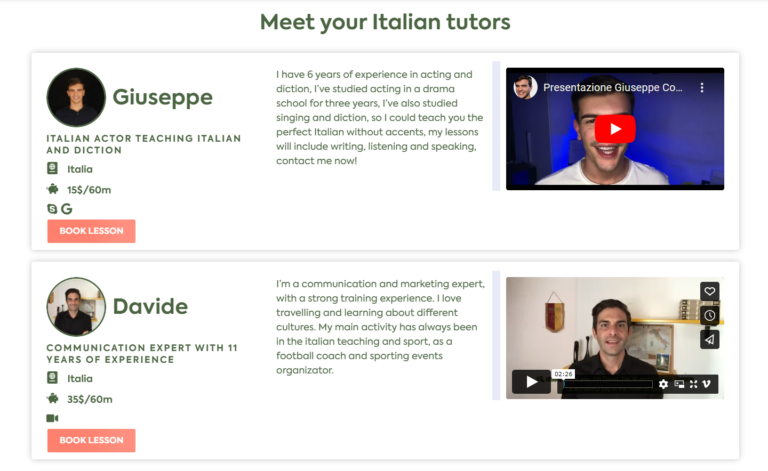
There are 2 tutors personally hand-picked by Stefano you can choose from. As mentioned on the site these tutors will ‘teach through examples, not grammar rules.’
If you prefer Stefano to coach you instead that option is available too.
It covers both learning Italian as well as lifestyle and culture.
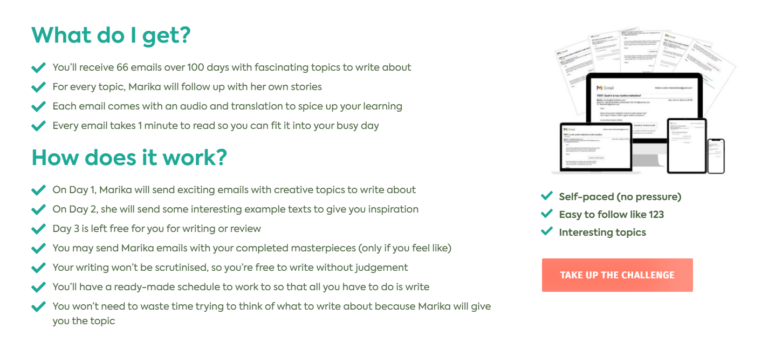
This is good for those who want to improve their writing skill. You can start anytime and it’s free.
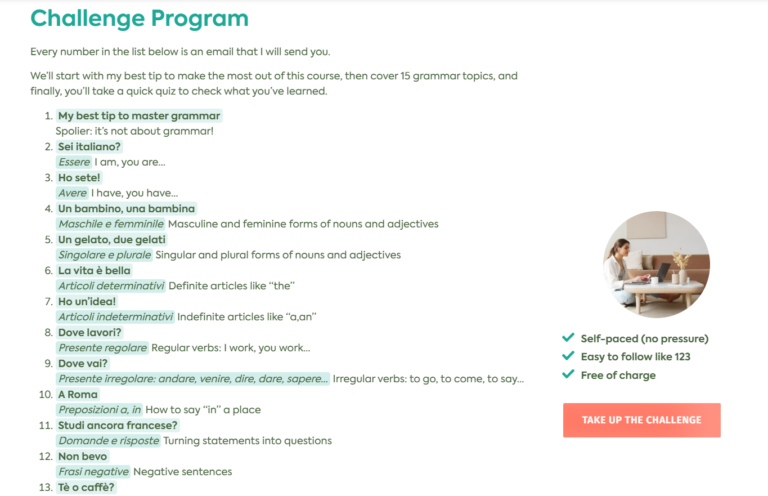
It’s a 30-day challenge (more like 16 days) It’s taken from the first 15 lessons of the total beginner level.
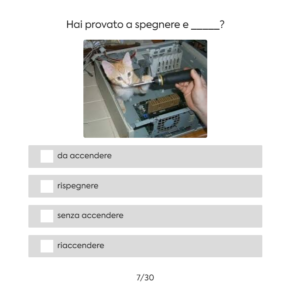
For A1, there are two grammar quizzes. For A2, there are three quizzes and for B1, there’s just one quiz. The results are instant and correct answers will be shown at the end. The questions are derived from the content of RCM lessons.
On every lesson, there’s a comment section below where users can leave a question(s) and Stefano will answer them within 24 hours. Others in the community who know the answers can reply to the comment too.
All these can be seen in this section.
Stefano is actively offering his support on the site. Should you have any problems, I’m sure he and the other support teams will get back to you promptly.
Each lesson has 3 parts named A, B, and C. Combining these parts together will last approximately 30 minutes as stated on the website. There are grammar notes for every lesson.
There are 30 sentences in all part A’s files. The same 30 sentences will be used again in the other 2 parts.
Below is the breakdown of how all the parts work.

Part A – First, he will say the sentence in English once and in Italian twice. You just have to listen.
Part B – First, he will say the sentence in English once. Then, there will be a pause for you to say the translation of it in Italian. After that, he will say the sentence in Italian once. All you have to do is follow along as he says it in Italian.
Part C – He will say the sentence in Italian once. As recommended by Stefano, you have to shadow him while he is still saying the sentence.
This is what the lesson looks like.
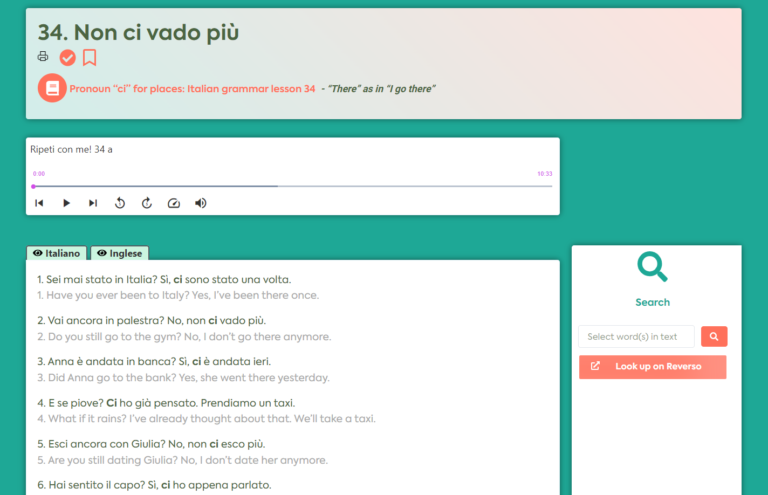
The top is where the audio player is. You can control the audio speed by clicking the meter-like icon. The middle part is the transcript. When you first open a lesson, it will be blurred. Just click on either Italiano or Inglese to reveal them.
On the right side is the option to look up words on a site called Reverso. At the bottom is the comment section. I recommend you read it first before commenting because there’s a possibility that others already asked the question you want to ask.
Since this is an audio-based course a guide on pronunciation can’t be missed. As for the grammar notes, it’s easily understood and not overwhelming. It has a Quizlet quiz to test our understanding.
Both versions have the same content. It's only a matter of whether you want to access it online for a certain period (depending on your payment plan) or offline and keep it forever.
Each downloadable MP3 has its own price ($133 by level/ $266 full course). Since you get to keep them, the price is a bit more expensive (at least compared with the monthly.)
Upon buying the course you’ll receive two PDF booklets along with the audio files. Check the intro PDF to see the complete guide and tips on how to use the course. The other booklet is the written English and Italian sentences of the audio.
You'll also get these complimentary resources for free;
It’s the same as RCM minus the grammar notes. Below the transcript, there’s a short test consisting of 4 questions (only on a few readings). LCM has 5 categories.
It’s recommended to do one story a day and to read it out loud. The audio length isn’t very long. First, listen to the audio without looking at the Italian transcript. Next, read the transcript. Finally, read the translation.
You can pay in USD ($), AUD ($), EUR (€), and GBP (£). Apart from offering a 7-day trial it also offers;
These 8 are what you'll get for each subscription;
You may be wondering why it’s written 250 audio instead of 249. As said by Stefano
‘there's one more about curse words but I didn't include it in the program.’
As for why 600+ he just needs to update it because he’s adding content regularly.
You can start the quiz in 3 ways; Open input, multiple choice, and conjugation drill. The latter is only available if there are supported verbs in the list.
Stefano has other products, such as placement tests (AI-powered Italian grammar and vocabulary placement test/ AI-powered Italian speaking placement test) and downloadable courses (Ripeti Con Me/ Leggi Con Me).
The latter is perfect if you prefer to buy just one specific course or specific level without the others and want to be able to access it offline.

This feature is something not everyone would want to do. When I asked what made him want to include this, here’s what he said
I receive traffic from low-income countries that don't convert anyway, so I might as well give away my courses. Money shouldn't be a problem with education, no? :)
Bravo, Stefano!
It will be available on both Android and iOS.
I’ve been using Think In Italian for over 2 months and went from total beginner to Elementary. Usually, I do both lessons in the morning (40 minutes) and review them again at night (15 minutes, only part B of RCP, and LCM).
Stefano recommends taking a night of sleep before reviewing the same lesson. I did that too when I wasn’t able to do the lessons in the morning and it works because I can recall most of them.
It also works the way I normally do. No, I don’t magically remember all the sentences. Some are easier than others. Is 9 hours after considered too soon of an interval?
This made me question myself after reading Stefano’s take on the Spaced Repetition System.
If you review information too early, you’ll waste your time. If you review information too late, you will forget it and will have to re-learn it. The best time to review information is just before you’re about to forget it – Stefano Lodola
The method (listen and repeat) isn’t really groundbreaking yet it has been overlooked occasionally perhaps because it’s too simple and easy. As far as I can see, there’s nothing passive about TII.
I wasn’t planning to do grammar when I was just on the beginner level but I had to because most questions I have are related to that. When Stefano asked if I had checked the grammar notes on one of his replies, I knew I had to.
So, I spend around 10-15 minutes depending on the difficulty of the topics.
While I was at it I decided to do the grammar challenge and I’m glad I did. It wasn’t as much as I initially thought.
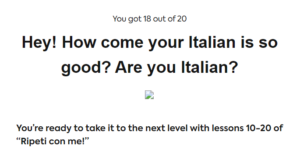
Not bad but as Stefano says
Tests are tricky. If they go worse than you expected, you feel frustrated. If they go well, you might become over-confident about your skills and then face reality when you get to speak to someone.
It’s true. I experienced that with Arabic back when I was in the university.
This course opens my eyes to the weaknesses of some popular apps/ sites. When you learn a language, it’s meant to be spoken, if that’s your goal. How ironic it is people are still using such apps that don’t highlight exactly that. Heck, I was guilty of it as well.
Anyway, if I can break down how my 4 skills improved after using this course it will be like this;
In terms of intonation, I feel like it’s a mix of multiple languages. Most of the time I’m a little confused about which syllable I should put the stress on.
At first, everything is foreign to me. Once I read the transcript and translation it becomes a bit easier when I focus on listening again without them after finishing each lesson.
This can change though if the speech rate is faster than the one used in the course.
I can read any sentence (at a normal speed only) easily because I don’t have a problem with pronunciation. However, I do accidentally pronounce words the Spanish way from time to time.
How I wish I could give the percentage a little higher but the things that prevent it are the accent marks and apostrophes. I’m fine with words like è, sì, and perché but with the rest, hmm...
The course design is very minimal and the lessons are very straightforward. All you have to do is listen and repeat (speak from day 1). I know it sounds too good to be true but it works. Obviously, you have to focus. You'd be disappointed if you expected some sort of gamification.
With most apps or sites, you probably do the active recall only after you’re finished. With RCM you do it while doing the lesson and after. That’s twice. While others start with A1 (beginner) TII starts with A0 (total beginner).
RCM doesn’t have a particular topic. The sentences are totally random and most are informal because ‘that's more logical grammarly and also common and useful for the average student.’
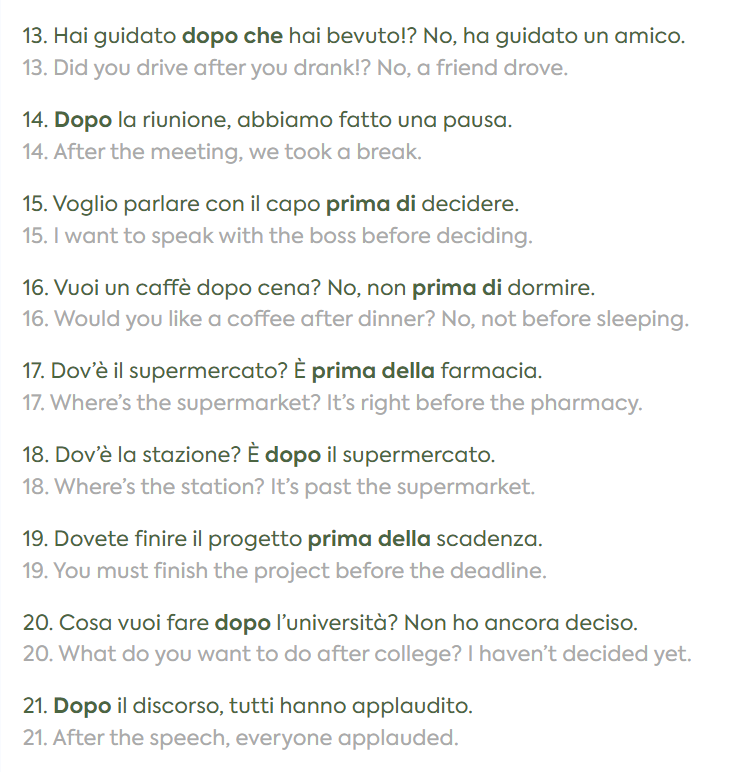
He incorporates basic grammar in the sentence naturally. He even bolded them so we know which one. As I began to focus on that I started to understand the structure of the sentence and frankly speaking, it does make learning noticeably easier.
I’m going to quote what he wrote in the intro booklet regarding the grammar as I think that’s one of the reasons why it’s effective, at least to me.
“Sentence patterns follow a plan shared by the most popular textbooks.”
Each grammar note is written based on what each RCM lesson is about. So, if lesson 5 deals with prepositions that’s what you’ll see there. Knowing why they are structured the way they are, what tenses they use, etc feels great.
It’s indeed just like grammar textbooks except without audio and videos.
There are a few mistakes in the notes if you really pay attention. However, they are quick to fix them when users point them out.
With the addition of Leggi Con Me, you learn more new vocabulary daily. Sometimes, words that are in Ripeti Con Me are also in the readings.
There are times when such words appear in the former and for the life of me, I just can’t remember but when they appear again in the latter repeatedly, I can remember them though not all the time.
Leggi Con Me is doable if you’re busy because they aren’t long. Some are less than a minute or two.
He uses 1,000 most frequent words. Since I already know the structure it’s only a matter of changing the word. This helps me narrow the vocabulary to those I most likely use in my daily life rather than a totally random one.
Even Benny, the Irish polyglot gives the same advice.
What Stefano intends to do with the course is to train our brains to think in Italian. I experienced that when I wrote an email to him in Italian two weeks after starting the course (without knowing the grammar).
No, I didn’t write fully in Italian. It’s just one sentence. I remember the words I wanted to use from the lessons. It’s like choosing one word from one sentence and the rest from another sentence. I didn’t even remember the English translation. It’s all Italian.
He wrote back to me completely in Italian. I was so surprised so I had to use Mr. Google. A month later, I read back the email and I understood every word he used. Such an awesome feeling!
He cares about the progress of his students. Hence, why he does the live streams, actively replies to pretty much all comments, and does chat support. He’s very hands-on about his own courses.
Having the ability to leave comments on every lesson is superb. It gives users an opportunity to ask any questions or doubts they have.
Want to test your understanding and knowledge so far? Take an online test when you finish each level. However, it only consists of multiple-choice questions.
The provided resources are satisfactory. The blog is informative enough to make you rethink what you already know.
The spaced repetition is great but personally, I’d prefer if there’s an interval reminder to revise the whole lesson.
For the Ripeti Con Me, some sentences are missing and wrong in the audio. A few users already pointed yet no corrections have been made. Hopefully, it will be fixed when they update the course.
For file B, he could use a beep that indicates when the learner should start replying to the question. Because for some long sentences, I got cut by him when I hadn’t finished saying them. The timing needs to be fixed.
That's normal. Some people make it and some need more time. You can always adjust playback speed. - Stefano Lodola
As for file C, he says the goal is to shadow him while he is still saying the sentence. That indirectly means we have to memorize all their orders. We can’t remember what the 5th, 10th, etc sentences are until he starts saying them.
No. You can shadow just by hearing the beginning of the sentence. There's no need to start before that. - Stefano Lodola
The main focus of Think In Italian is speaking, listening, and reading. If writing is the skill you want to improve you won’t get it here. However, that doesn’t mean you can’t do it. There are two ways but it takes time.
For example, after finishing each lesson click on the English translation and write the Italian translation yourself. Compare both, take notes of your mistakes and correct them.
Or, while doing lesson C after hearing each sentence write them down and check the mistakes when you’re done.
The user experience (UX) is slightly difficult. One day, I wanted to check out the community forum but I couldn’t find it on the top menu or the bottom. I have to check my email to get the link because I found out about it through the newsletters.
This grammar section should be on the menu as well. I know it’s on the main dashboard but to find a specific grammar note you have to change your level first.
There’s no way to bookmark grammar notes either which is unfortunate. I really hope they make this available just as they did with RCM and LCM.
The ‘last viewed’ section became a problem when I reached lesson 45. I was no longer able to view the last lesson I’d done. I’m guessing it’s limited to a certain number and when it reaches that nothing new appears.
It’s one of the features I like. Now, I have to scroll all the way down to get to them. Imagine wanting to get to lesson 50 out of 60.
At times, the website loading is slow. A few pages load fine but others, not so much. Did I mention it crashes too? Stefano needs to fix these.
Stefano replied to most comments in Italian. Even on the A0 level. He replied to mine and I didn’t understand because I hadn’t learned the word being used yet. Sure, I can use Google Translate but that’s not the case.
There are no exercises or images. The former is important to strengthen furthermore of the learner’s understanding. The same goes for the latter. Visuals definitely help us learn and memorize better. Based on this reason only I can’t help but compare it with Pimsleur.
“Words are abstract and rather difficult for the brain to retain, whereas visuals are concrete and, as such, more easily remembered.” – psychologytoday.com
It keeps using the US and Europe as examples. Why not diversify the country and nationality? How about Asia? Latin America?
I try to keep content relevant to Italian learners. It's more likely that they're interested in Europe than Africa. Anyway, I do use some Asian countries. - Stefano Lodola
The quality of the live streams isn’t good (max 480p). It’s buffering a lot. Can’t really blame him though. The internet is unpredictable.
All in all, I can honestly say it’s worth it and I give this course 4.6 stars. Yes, a few improvements are needed, but it’s truly a good audio course.
I recommend you try Think In Italian for all the reasons I stated above. However, I wouldn’t recommend relying only on this to improve your skills. You can certainly add it as one of your methods and supplement it with the others.
I would like to thank Stefano for introducing his course to me. Now, I can add Italian to the list of languages I want to pursue in the future and TII will be the first course I use.
Have any of you experienced using this? How did it go? Do you agree or disagree with my opinions? You’re welcome to share your feedback in the comment section below.
©2025 Together We Learn More
©2025 Together We Learn More